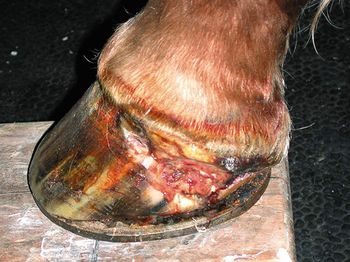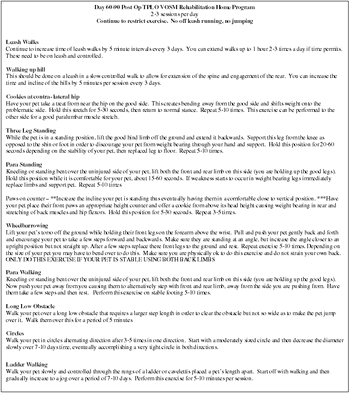
Antibiotic therapy is an important component of treating infections, but its efficacy depends on achieving adequate tissue concentrations at the infection site.

Antibiotic therapy is an important component of treating infections, but its efficacy depends on achieving adequate tissue concentrations at the infection site.

Study results indicate possible need for testing in these patients.

Students hone surgical skills before operating on the real thing.

Advice for formulating your surgical plan.

Bargain-basement spays, neuters do more harm to the veterinary profession, than good for animals.

Why surgery is indicated for this condition.

Is there an early radiographic marker for hip dysplasia in dogs?

Identifying the cause of forelimb and hind limb lameness in dogs can be a challenge. Until recently, diagnostics in small animal orthopedics included visual gait analysis and radiographs. With advanced diagnostics becoming more readily available (objective gait analysis, CT scan, MRI, ultrasound, nuclear scintigraphy, arthroscopy, etc) clinicians can now obtain a definitive diagnosis to those challenging conditions.

Injuries to the carpus and tarsus are common in agility and sporting dogs. The carpal and tarsal joints act as sock absorbers for the limb during weight bearing. They are prone to injury due to their complexity and lack of muscular support. The complexity of these joints creates a diagnostic problem for many veterinarians. Many carpal and tarsal injuries, particularly those that go undiagnosed or untreated, can result in an increased risk of osteoarthritis and potential long-term lameness.

Fracture repair results in the creation of a bone-implant composite. Although most of our interventions for fracture repair are successful, at times it seems as though there are an endless number of errors that may prevent the fracture from healing. Fortunately, once the cause of the complication is recognized, the underlying problem can often be corrected and a successful outcome eventually attained.

Non-steroidal anti-inflammatory drugs (NSAIDs) are widely used to control acute and chronic pain in veterinary patients. The presence and activity of two isoforms of the cyclooxygenase (COX) enzyme, a constitutive COX-1 and an inducible COX-2, have been investigated intensely since the early 1990s.

The stomach is a C-shaped musculoglandular organ. It has the largest dilatation of the alimentary canal. The stomach lies mainly in a transverse position, Predominantly to the left of the median plane. When it is empty, the stomach lies cranial to the last rib and between the ninth thoracic and first lumbar vertebra.

The ability to diagnose the cause of a lameness is essential to the small animal clinician. In our day to day practice settings, dogs and cats present with a variety of lamenesses. Many of these problems resolve with rest, or a diagnosis is readily available (cut pad, ingrown nail, etc?).

Urine diversion techniques are performed to temporarily or permanently divert urine from its normal anatomic course from the kidney through the ureter to the bladder and finally through the urethra. Veterinarians are most familiar with temporary urine diversion (urethral catheters) that are often used to stabilize animals that are sick as a result of metabolic changes associated with urinary tract obstruction.

Rabbits should be spayed anytime after 5 months of age. When very young, the uterine horns and ovaries are very tiny making identification challenging. However, in older mature and perhaps overweight rabbits, the mesometrium is extremely fatty and friable. OVH is indicated in all female rabbits to prevent pregnancy, control territorial aggression, prevent uterine neoplasia (80% incidence), or other uterine disorders such as pyometra.

Laryngeal paralysis is a congenital or acquired disease that causes upper airway obstruction. Paralysis causes partial or complete obstruction of the laryngeal lumen due to denervation of the cricoarytenoideus dorsalis muscle of the larynx. Interruption of nerve transmission from the recurrent laryngeal nerve or the vagus results in failure of the arytenoid cartilages and vocal folds to abduct on inspiration.

The pinna of the external ear may vary a great deal between breeds. There are two cartilage segments that support the external ear and the ear canal. The auricular cartilage forms the pinna, the base of the ear, the horizontal and part of the vertical canal. The annular cartilage acts as the framework for the vertical canal and is attached to the external acoustic process and the auricular cartilage.

This text is not intended to cover each and every aspect relating to wounds presented in veterinary medicine. It is, however, designed as a simplified handbook, which will assist members of the veterinary medical team in properly assessing patients and their wounds.

Traumatic fragmented medial coronoid process (TFMCP) is a condition in the elbow joint of dogs that appears to occur commonly in performance dogs. Unlike the classic condition of fragmented medial coronoid process (FMCP) affecting the elbow joints of skeletally immature large to giant breed dogs, jump down syndrome (TFMCP) appears to have no age or size limitations.

While considered a very common problem in small animal medicine, osteoarthritis is very likely the most under diagnosed, and misunderstood rheumatic disease in dogs and cats. Part of the problem veterinarians face with OA is that it is a slow, progressive and often insidious problem.

It is important to understand that when a dog presents with a dog with hip laxity (hip dysplasia) with or without secondary degenerative changes, that there is not one single way to manage every patient. Initially, one must decide if a particular patient is better suited for medical or surgical options.

Current treatment options for osteoarthritis are extensive and can be categorized into medical/ conservative or surgical therapies. Medical therapies may consist of weight control, exercise modification, rehabilitation therapy, pain management medications, oral joint protective compounds, and intra-articular treatments.

The most common hind limb orthopedic/sports medicine conditions afflicting active dogs are iliopsoas strains, cranial cruciate ligament (CCL) insuffiency and gracilis and semitendinosus contracture. Of the hind limb muscular injuries iliopsoas strain is, by a considerable margin, seen more frequently than gracilis and semitendinosus contracture.

There are numerous studies indicating the positive benefits of rehabilitation therapy following CCL surgery. In summary, rehabilitation therapy has been shown to improve muscle mass and attenuate muscle atrophy that occurs in the post-operative period, increase stifle joint ROM, especially extension, improve weight-bearing as measured by force plate analysis, and reduce the progression of osteoarthritis.

Soft tissue injuries and osteoarthritis are common conditions afflicting active dogs due to the repetitive forces placed on the joints. Microtrauma to the tendons, ligaments, and the articular surfaces of joints can occur, creating an environment for osteoarthritic development.